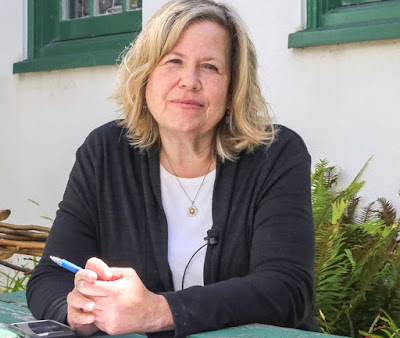 |
| Dr. Frankovich, Humboldt County Public Health Officer |
After Jackson failed to return her urgent phone call, Dr. Frankovich, Humboldt's public health chief, sent a long email. She ended it with with this summation (with my emphasis added): “I completely understand the enormous impact of this for all involved, including our local community and cannot tell you how much I regret that I do not see any way in which public health can support on-site instruction and dorm living at this time.”
She noted that testing capacity alone was insufficient. "These resources would clearly fall short in meeting demand for a large surge occurring in context of a return of students to dorms and on-site learning at HSU.. Robust testing with fast turnaround is essential to manage cases on campus that will inevitably occur and are very likely to occur quickly as we bring students from across the state to the area, many of whom are coming from places where disease circulation is vastly higher than ours. There will be positive students walking onto campus without question and congregate housing will increase transmission risk enormously. ”
Dr. Frankovich wrote that the return of students could overwhelm the county's current capacity for contact tracing, which the guidelines also required. "While we are managing our current caseload well, we are positioned such that a large number of cases occurring in a short time frame such as return to campus, would be a potential tipping point for overwhelming the system, risking wider spread of the virus."
 |
| HSU President Tom Jackson |
He further accused her of "prejudicial statements" in regard to students from elsewhere as potential carriers, when the publicly available statistics from Public Health clearly show that the recent influx of cases in Humboldt have largely been driven by infections from outside. And to ignore the data from places like southern California is entirely specious, rhetorical nonsense.
Jackson then threatens the entire community by asserting that if students can't live in dorms they would be released into the community where HSU would have less control over them. This gives those of us living in neighborhoods into which students are currently returning an eye-opener, as if we needed one. With the dorms monitored, are these places where the superspreader parties will be?
Jackson absurdly asserted that students are "county residents" even if they've been living hundreds of miles away, and made other rationalizations and arguments that had nothing to do with the Public Health Officer's analysis. He chastised Humboldt County Public Health for not scaling up its resources sufficiently to accommodate HSU's reopening--the "I am not responsible" defense.
Jackson began his email stating that regardless of Dr. Frankovich's statement, HSU was going ahead with its plans to reopen, and imperiously demanded: "If you have any further plans to use your authority to obstruct this plan..., we must be informed immediately." He ended his email: "I am copying a number of important individuals so they are aware of this email and its context." That "important" individuals seems an unusual construction, unless of course you are trying to intimidate a public servant.
By Dr. Frankovich's end of the week press conference, where for the first time she actually got questions about HSU's reopening, she acknowledged that HSU's reopening was now a fait accompli and Public Health and the community would have to just make the best of it.
The Times Standard notes that over 200 students have already arrived, and that officially HSU now expects to house 800 students. There was no number given regarding students to be housed in the community.
HSU is on schedule to be the only CSU school with in-person classes, estimated (according to T-S) at more than 300.
T-S also notes that half the virus positives registered in Humboldt County this year have come in the past 45 days, and the past week has seen three new hospitalizations. Most new cases, Public Health previously reported, were from the 20s age group.
HSU hurriedly made one important concession--on Friday the university added its own virus testing for incoming students. Before that, it wasn't going to bother. How robust or effective this will be is anyone's guess, but I wouldn't view it with a high degree of confidence.
So without an order from the Chancellor of CSU or an order from the Governor, Arcata and Humboldt County will be endangered by hundreds of outsiders--students and their families--coming in, who may or may not obey masking and social distancing laws--and somewhere in the neighborhood of 700 to 800 students in the dorms and going to class, with an unknown number of other students interacting with them in classrooms and socially, and returning to their housing in the community, interacting with grocery workers and others in Arcata. But Jackson will get his dorm fees and tuitions.


















